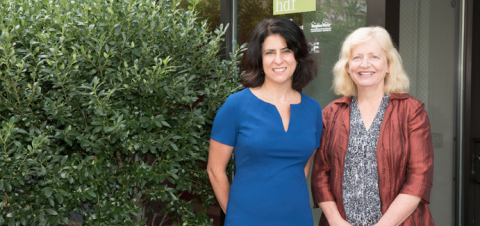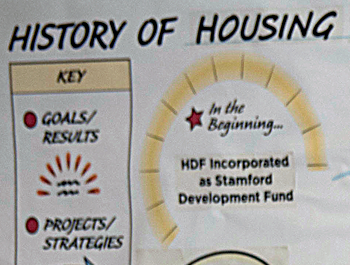Image

Joan Carty, President and CEO
Suchana Costa, Innovations Analyst
Housing Development Fund
Challenge: As organizations expand, manual systems that might once have been adequate can no longer keep up with the increased workload. Adopting new technology platforms improves speed and efficiency but it can be challenging to find the appropriate technology, motivate staff to embrace changes and work new technology into existing systems.
In 1989, the Housing Development Fund (HDF) was established to promote affordable housing through low-interest development loans in Stamford, CT. Today, HDF has expanded its services and products to include lending and advising services for developers and first-time homebuyers throughout the entire state of Connecticut and Nassau, Suffolk, Rockland and Westchester counties in New York. Over the past 27 years, HDF financed nearly 60 multifamily properties, advised and educated nearly 9,000 households and closed more than 2,000 loans. As HDF expanded, the need for innovative methods to keep track of our external and internal operations grew. In response, we implemented a series of technological upgrades, beginning with the NeighborWorks' Sustainable Homeownership Pilot in 2014.
Prior to these technology changes, potential first-time homebuyer clients called the main office, downloaded a pre-application form and gathered financial documents before they could sign up for a required group orientation session where they received an overview of products. Next, they met with a homeownership advisor to determine eligibility and create an action plan to become homeowners. Once they found a property, they downloaded required forms and gathered documents before closing. Clients were encouraged to attend post-purchase events and complete paper surveys.
HDF maintained the list of attendees at each weekly orientation session in several locations: EventSpot (an online event manager), Counselor Max and Outlook, which meant that all three systems had to be updated for visibility and email reminders. There were also physical files with action plans, financial records and grant documents for each client that took staff time to maintain.
 The new technological platforms allow clients to create an account on a customer portal site, update their personal and financial information, schedule appointments, share documents with staff, send emails and keep track of their own progress through their account. Clients can complete these profiles at their own pace, which helps us keep track of clients who are interested but not yet ready. In the past, only clients who attended an orientation session would enter their record system. Clients can now watch an orientation video, submit their financial documents through the portal and review an action plan during a virtual advising appointment without taking time off from work to visit an HDF office.
The new technological platforms allow clients to create an account on a customer portal site, update their personal and financial information, schedule appointments, share documents with staff, send emails and keep track of their own progress through their account. Clients can complete these profiles at their own pace, which helps us keep track of clients who are interested but not yet ready. In the past, only clients who attended an orientation session would enter their record system. Clients can now watch an orientation video, submit their financial documents through the portal and review an action plan during a virtual advising appointment without taking time off from work to visit an HDF office.Salesforce, a customer relationship management system, allows advisors to interact with and track their clients. The Salesforce record can be updated by both the client and advisor at any time. Clients are automatically dispatched to their next step after completing a profile, such as financial fitness, homebuyer education or advising. The system generates a list of tasks associated with each client for advisors. All communications are recorded on the customer's profile, including auto-generated emails sent to them as they reach new milestones. All advisors have access to all client information, making transferring clients easy.
Via online surveys, we received overwhelmingly positive reviews on the convenience of the new process and customer portal. The implementation of Microsoft Azure (cloud data storage), Microsoft 365 (cloud email), Abila (grant and finance management), Encompass Banker Pro, ADP (time reporting) and Concur (expense reporting) further reduced paperwork and manual data entry. We can now obtain financial statements in five days rather than 30 days.
The movement away from redundant and laborious data entry allowed us to focus on analysis of data to more accurately assess efficacy of programs and social impact. For example, replacing spreadsheets with ADP for project-based time reporting and payroll allowed us to quickly determine how much time staff spends on different projects. In addition to real-time analysis, we ran reports using historical data to identify external bottlenecks in our internal processes. Using Salesforce reports, we discovered that a majority of clients who did not complete a profile after being contacted by staff three times never became customers, so we reduced the number of required contact attempts by staff from six to three.
HDF's complete technological turnover has had challenges. We learned that while some changes, like the new Voice Over IP (VOIP) phone system, were seamless, others required training and patience as staff adjusted to completely new methods. However, any initial reluctance to learn a new system was quickly quashed as staff enjoyed completing previously time-consuming tasks in a fraction of the time.
By adopting new technology, HDF is able to better serve its mission. We can reach and maintain more clients in our system, work more efficiently and ultimately promote affordable housing in a more creative and effective manner.

